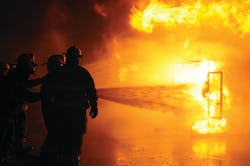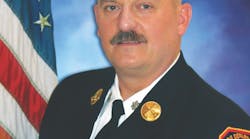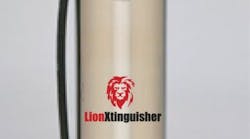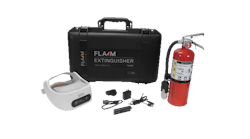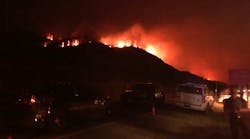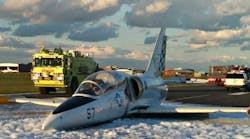The U.S. military is our nation’s most elite group of individuals. They have led our nation to victory in many battles. I do believe, however, none of these victories have come without a precise and thought-out method of attack. Many hours are spent in reconnaissance training to figure out the enemy’s strengths and weaknesses before engaging in battle. A ground war is fought and won, not just with a minimum amount of artillery in hopes that it will be sufficient, but to overwhelm the enemy with the goal in mind never to return.
The fire service is engaged in a war, like it or not, against an enemy that has already invaded our homes and is ready to show itself in a very hostile manner. This enemy is petrochemicals. Your favorite chair, sofa bed or other piece of furniture may seem quite harmless, but its components are killing firefighters in quite a subtle fashion.
The heat release rate (HRR) of these materials is without a doubt catching our brothers and sisters off guard. We cannot be fooled into thinking that these furnishings are just as they appear (like an ordinary piece of furniture), but we need to treat them as highly flammable sources of fuel.
Let’s take a look at the driving force the HRR has on interior structural fires. The HRR is a measurement of heat energy released over a specific unit of time. A fuel has a specific heat of combustion or a total amount of energy released when burned. Different materials possess a given amount of potential energy, such as bottle rocket with a low potential energy compared to a stick of dynamite. When this energy is released as kinetic energy by the combustion process, it is a concern for us. This energy is measured in kilojoules (kj) per gram. How fast this energy can be released is the heat release rate, which is measured in kj per second.
The potential energy of a synthetic material such as polystyrene yields an energy of 39.58 kj/g, almost identical to propane, which yields 46.45 kj/g. The HRR is an exponential phenomenon, meaning that heat makes more heat. A high HRR directly indicates a high threat to life, rapid temperature changes, faster flashover times and an increase in products of combustion. A single overstuffed chair made out of polystyrene has enough energy to drive a 10-by-10-foot room to flashover. The HRR can be viewed as the engine driving the fire.
Flow rates
We should not depend on flow rates any less than 150 gpm for interior structural fires. Flow rates below 150 gpm are inadequate to overwhelm compartments that are filled with synthetic materials. The HRR given off by these synthetics must be controlled with the correct stream and volume of flow to overwhelm such rapid fire events.
You want to enter a structure with a 200-foot pre-connected handline combination nozzle set on straight stream flowing 150 gpm, with a 170 psi at your pump panel. Before making entry, your captain wants the engineer to just back the pressure down to 130 so you can move it around easier. (Sound familiar?) Now, are you really receiving adequate flow? You have just dropped your psi by 25%, so what have you done to your gpm? You now have 115 gpm. This gpm is woefully inadequate and not a safe practice. You may be merely containing the fire and not extinguishing it.
Hose streams
Let’s take a look at streams produced from the combination nozzle in comparison to the solid streams produced by the smooth bore. The combination offers you two stream choices. We will start with the discussion of the fog stream.
The 1950s brought about the use of the fog-stream application by Chief Lloyd Layman, who at the time conducted studies based on U.S. Coast Guard and Navy experiments. In these studies, the fog pattern produced great heat-absorption abilities. Two requirements for success with this stream were ceiling temperatures of at least 1,000 degrees Fahrenheit and the fire being attacked must be in a sealed compartment. He also stated that the stream should be remotely injected to ensure no injuries to firefighters from super-heated smoke and stream. This was called the indirect method of attack.
In none of Layman’s findings did he mention using this technique in an area firefighters or victims would likely occupy. The fog stream has a much larger surface ratio and little, if any part, of the broken stream contacts the solid surfaces or fuel source. Remember, our goal is to apply water to the fuel source and not to just cool off the thermal layer. Many advocates of the combination nozzle state that they prefer this type of nozzle for the versatility to adjust the pattern, narrow or wide. Others also state that they would never actually open up to a fog pattern when they are operating inside due to steam conversion. Then why take the fog nozzle into the structure to start with?
The answers usually include the desire to hydraulically ventilate, the need for the extra protection, or just in case. Fog streams flowing 150 to 180 gpm produce over 6,000 to 10,000 cfm compared to a solid-tip 15/16 that produces 510 cfm, but our main focus here is fire suppression. If our main focus is stretching the initial attack line for ventilation purposes, we need to reevaluate our thinking. Let’s leave the ventilation to the truck companies. Our main focus for the initial stretch should be proper extinguishment.
We have been fooled for many years believing that a curtain of water between you and the fire is protection. What is occurring is you are pushing heat, fire, smoke and other products of combustion out in front of you, which is not a bad thing if you are fighting a vehicle fire outside. The pushing effect gives you a false sense of security because what you have pushed away is likely to return to you. Fire, heat and smoke will seek the path of least resistance and potentially extend your fire vertically and laterally.
I have witnessed in several training evolutions combination nozzles advanced into structures and rotated accidentally on whatever they come in contact with. One would not like to be on the receiving end of the fog stream that has been injected into the thermal layer. While I personally advocate the use of solid streams, if a combination nozzle is the only option, it should be used in a straight-stream position with an adequate rate of 150 gpm. A solid or straight stream will provide a rapid knockdown with less violent disruption of the thermal layer, and is more likely to reach the seat of the fire due to less premature conversion to steam or carried away by convection currents.
Although their use in direct attack is similar, straight and solid streams have distinct differences. A straight stream, in essence, is a very narrow fog stream. It is produced by a combination nozzle and is made up of millions of tiny water droplets divided by air entrained within the stream. Narrow streams produced by combination nozzles are not “solid streams.” A solid stream is produced by a smooth bore orifice and is a compact, solid cylinder of water as it leaves the nozzle. Proper tip pressure will allow this stream to remain compact for a considerable distance before friction with the air; gravity and other factors destroy the quality of the stream. One important reason solid streams are more effective than straight streams in interior fire attack concerns the water droplets.
When a solid stream is deflected off the walls and ceiling, it produces droplets of sufficient mass and size to reach the burning fuel without being carried away by the thermal currents or prematurely vaporized by the heat. Straight streams created by fog nozzles are the result of changing the direction of water travel inside the nozzle by striking the stream against the deflector. This consists of countless droplets that are now even smaller when colliding with the ceiling and upper walls. These small droplets are drawn into and propelled out of the thermal column of the fire, never to reach the burning fuel.
Ready for battle
We must be ready for battle with effective hoseline selection, nozzle selection and flow rates to overwhelm this driving force of fuel. It is our duty to be proactive when it comes to the constant changes our profession brings. We owe this to ourselves and to the citizens we serve.
I want to stress that the information and recommendations here are related to interior structural firefighting and are techniques that are proven to be effective and provide the greatest chance for survival and extinguishment.
Jason Sowders
Captain/EMT
Bowling Green Fire Dept.
Bowling Green, KY
The writer is a 13-year veteran with the department, company commander and captain of training. He has served as a Firefighter I, Firefighter II, Fire Service Instructor, State Fire Instructor, Incident Safety Officer and Hazmat Technician.
(References: Dr. Vytenis Babrgoskas, Heat Release Rate: A Brief Premier; Andrew A. Fredericks, Return of the Solid Stream, Methods of Structure Fire Attack, Hand Line Selection and Stretching the Initial Attack Line, Fires Are More Dangerous Today; David Fornell, Firestream Management; and Dave McGrail, Operations in Highrise Buildings)
Arrival reports
I’ve been enjoying reading Mark Emery’s multi-part series, “How to Nail Your First-Due Strategic Responsibility” (see page XX). It seems like we, as company officers, are stretched so thin on the fireground that we do botch our arrival reports because we’re in a mad dash to get a thousand things done in two minutes – with less staffing. I thank and applaud Chief Emery for the work he is doing for us.
Beau Gardner
Lieutenant/Paramedic
Port Orange Fire Rescue
Port Orange, FL
